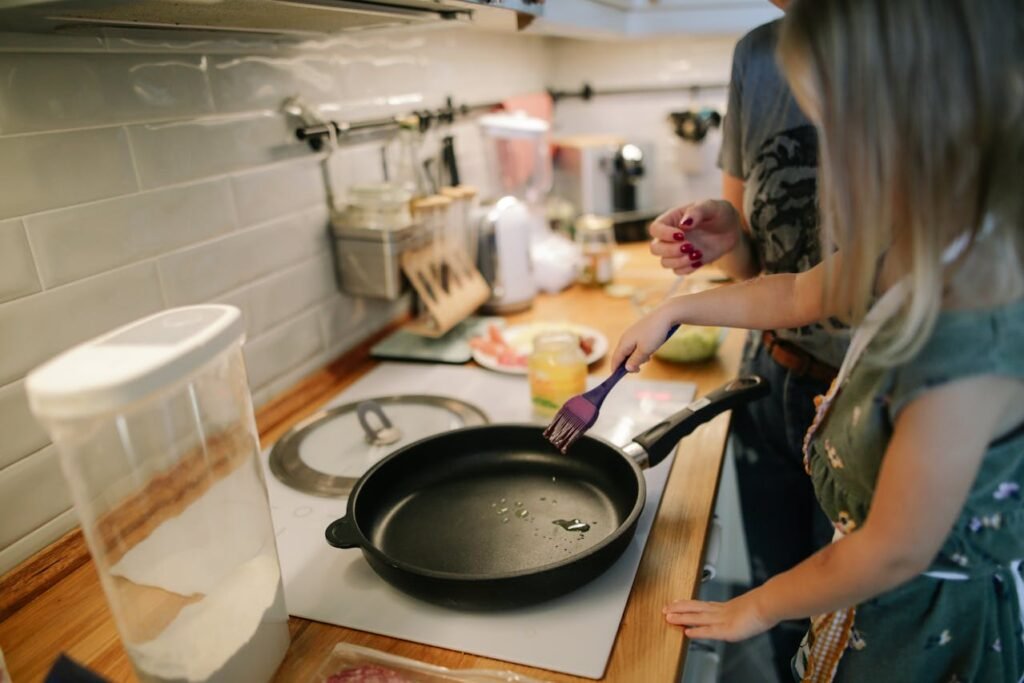Meal preparation has transformed from a niche practice to a mainstream lifestyle strategy, helping busy families save time, money, and stress while maintaining healthy eating habits. However, successful meal prep requires more than just cooking in bulk—it demands understanding of food safety, proper storage techniques, and strategic planning to ensure meals remain nutritious and delicious throughout the week.
Benefits of Strategic Meal Preparation
Meal preparation offers numerous advantages beyond convenience, supporting both health goals and practical lifestyle needs. Research consistently shows that people who engage in meal planning and preparation tend to have better diet quality, consume more fruits and vegetables, and maintain healthier weights compared to those who rely on spontaneous meal decisions.
The British Nutrition Foundation emphasises the importance of meal planning at https://www.nutrition.org.uk/putting-it-into-practice/food-planning/ highlighting how strategic preparation supports balanced nutrition whilst reducing food waste and saving money.
Health and Nutrition Benefits
Portion Control: Pre-portioned meals help maintain appropriate serving sizes, supporting weight management goals without requiring constant measurement or calorie counting.
Nutrient Balance: Planning meals in advance allows for careful attention to nutritional balance, ensuring adequate protein, vegetables, and whole grains throughout the week.
Reduced Processed Food Reliance: Having prepared meals readily available reduces temptation to choose convenient but less nutritious fast food or heavily processed options.
Consistent Eating Patterns: Regular meal timing supports stable blood sugar levels and helps establish healthy eating routines for the entire family.
Practical Advantages
Time Efficiency: Spending a few hours preparing meals weekly saves significant daily cooking time, particularly valuable for busy weekdays.
Cost Savings: Bulk purchasing and preparation reduces per-serving costs whilst minimising food waste through strategic use of ingredients.
Stress Reduction: Knowing that healthy meals are ready eliminates daily meal decision fatigue and reduces last-minute scrambling for dinner solutions.
Family Coordination: Prepared meals make it easier to accommodate different family schedules whilst ensuring everyone has access to nutritious options.
Food Safety Fundamentals for Meal Prep
Batch cooking and storage create unique food safety challenges that require careful attention to prevent foodborne illness whilst maintaining food quality.
Temperature Control Principles
Rapid Cooling: Cool cooked foods quickly by dividing large batches into smaller, shallow containers that allow heat to dissipate efficiently.
Safe Storage Temperatures: Maintain refrigerator temperatures below 4°C and freezer temperatures at -18°C or lower to prevent bacterial growth.
Reheating Guidelines: Heat prepared meals to at least 75°C throughout before consuming, ensuring even heating by stirring and checking multiple spots.
Time Limits: Use refrigerated prepared meals within 3-4 days and frozen meals within 2-3 months for optimal safety and quality.
The NHS provides guidance on food storage safety at https://www.nhs.uk/live-well/eat-well/food-guidelines/food-hygiene/ emphasising proper temperature control and storage duration for maintaining food safety.
Container Selection and Storage
Appropriate Materials: Choose food-grade containers that seal tightly and are suitable for both refrigerator and freezer storage.
Size Considerations: Use containers sized appropriately for intended portions to minimise air exposure and maintain food quality.
Labelling Systems: Clearly label containers with contents and preparation dates to ensure proper rotation and prevent confusion.
Stackable Design: Select containers that stack efficiently to maximise refrigerator and freezer space whilst maintaining organisation.
Strategic Meal Planning Approaches
Weekly Planning Cycles
Menu Development: Plan weekly menus that incorporate seasonal ingredients, family preferences, and nutritional goals whilst considering preparation time and complexity.
Shopping Lists: Create detailed shopping lists based on planned meals, including quantities needed for batch preparation.
Prep Day Scheduling: Designate specific times for meal preparation, typically weekends, when schedules allow for longer cooking sessions.
Flexibility Integration: Build flexibility into plans to accommodate schedule changes, unexpected events, or ingredient availability variations.
Batch Cooking Categories
Base Ingredients: Prepare versatile base ingredients like cooked grains, roasted vegetables, and cooked proteins that can be combined into various meals throughout the week.
Complete Meals: Cook entire meals that can be portioned and stored for quick reheating during busy weekdays.
Partial Preparation: Prep some meal components in advance whilst leaving final assembly or cooking for mealtime to maintain optimal texture and freshness.
Freezer Banking: Prepare extra portions of favourite meals for longer-term storage, creating a bank of ready meals for particularly busy periods.
Nutritional Considerations for Prepared Meals
Maintaining Nutrient Quality
Vitamin Preservation: Some vitamins, particularly vitamin C and B vitamins, can degrade during storage. Include fresh elements at serving time to boost nutritional content.
Texture Management: Certain vegetables may become softer during storage. Plan cooking methods and storage times to maintain acceptable textures.
Fat Considerations: Healthy fats from nuts, seeds, and avocados are best added fresh rather than stored with prepared meals to prevent rancidity.
Seasoning Adjustments: Flavours may intensify or diminish during storage, requiring adjustment of seasonings or addition of fresh herbs at serving time.
Balanced Meal Components
Protein Sources: Include adequate protein in each prepared meal to support satiety and nutritional needs. Consider both animal and plant-based options for variety.
Vegetable Integration: Incorporate vegetables into prepared meals in ways that maintain quality during storage, such as roasting or incorporating into sauces and stews.
Whole Grain Inclusion: Add whole grains for sustained energy and fibre, choosing varieties that reheat well and maintain pleasant textures.
Healthy Fat Addition: Include sources of healthy fats that complement other meal components whilst supporting nutrient absorption and satisfaction.
Age UK provides practical guidance on meal preparation for older adults at https://www.ageuk.org.uk/information-advice/health-wellbeing/healthy-eating/ including considerations for maintaining nutrition during storage and reheating.
Efficient Batch Cooking Techniques
Kitchen Equipment Optimisation
Multi-Tasking Appliances: Utilise slow cookers, pressure cookers, and oven space efficiently to prepare multiple components simultaneously.
Sheet Pan Cooking: Roast various vegetables and proteins together on sheet pans for efficient preparation and easy cleanup.
One-Pot Meals: Prepare complete meals in single pots or pans to minimise cleanup whilst creating flavourful, balanced dishes.
Food Processor Use: Employ food processors for efficient chopping, grating, and sauce preparation to reduce manual prep time.
Time-Saving Strategies
Ingredient Prep: Wash, chop, and prepare all ingredients before beginning cooking to streamline the preparation process.
Assembly Line Approach: Set up assembly lines for portioning meals into containers, making the packaging process efficient and consistent.
Parallel Cooking: Coordinate cooking times so multiple dishes finish simultaneously, maximising kitchen efficiency.
Clean-as-You-Go: Maintain clean workspaces throughout preparation to prevent overwhelming cleanup at the end of cooking sessions.
Storage Solutions and Organisation
Refrigerator Organisation
Temperature Zones: Understand that different refrigerator areas maintain different temperatures and store foods accordingly for optimal safety and quality.
First-In-First-Out: Organise prepared meals so older items are used before newer ones, preventing waste and ensuring food safety.
Clear Visibility: Arrange containers so contents are easily visible, encouraging consumption of prepared meals rather than defaulting to less healthy options.
Air Circulation: Avoid overcrowding refrigerator shelves to ensure proper air circulation and consistent temperatures throughout.
Freezer Management
Portion Sizing: Freeze meals in portion sizes appropriate for typical consumption to avoid thawing more than needed.
Freezer Inventory: Maintain lists of frozen prepared meals with dates to ensure timely consumption and prevent freezer burn.
Proper Wrapping: Use appropriate freezer containers or wrapping materials to prevent freezer burn and maintain food quality during storage.
Strategic Placement: Organise freezer contents so frequently used items are easily accessible without requiring extensive searching.

Family Meal Prep Strategies
Accommodating Different Preferences
Base Plus Additions: Prepare neutral base meals that can be customised with different sauces, seasonings, or additions to suit individual preferences.
Component Separation: Store meal components separately when family members have different preferences, allowing for customisation at serving time.
Kid-Friendly Adaptations: Prepare family meals with options to modify textures, seasonings, or presentations to appeal to children whilst maintaining nutritional value.
Dietary Restrictions: Plan prep sessions to accommodate family members with allergies, intolerances, or special dietary needs without requiring separate meal preparation.
Involving Family Members
Age-Appropriate Tasks: Assign preparation tasks suitable for different family members’ ages and abilities, making meal prep a collaborative family activity.
Teaching Opportunities: Use meal prep sessions as opportunities to teach children about nutrition, food safety, and cooking skills.
Responsibility Sharing: Distribute prep responsibilities among family members to reduce individual workload whilst building life skills.
Menu Input: Include family members in menu planning to ensure prepared meals will be enthusiastically consumed throughout the week.
Tommy’s charity provides information on healthy eating during pregnancy at https://www.tommys.org/pregnancy-information/im-pregnant/nutrition-in-pregnancy including meal preparation strategies for expectant mothers.
Troubleshooting Common Meal Prep Challenges
Quality Maintenance Issues
Texture Problems: Address vegetables becoming mushy by slightly undercooking them initially or adding crisp elements at serving time.
Flavour Changes: Compensate for flavour intensification or loss during storage by adjusting seasonings or adding fresh elements when serving.
Separation Issues: Prevent sauce separation by using appropriate thickening techniques and proper storage methods.
Staleness Prevention: Maintain freshness by using proper storage containers and consuming prepared meals within recommended timeframes.
Motivation and Consistency
Start Small: Begin with preparing just a few meals weekly rather than attempting complete meal prep overhauls that may feel overwhelming.
Gradual Expansion: Slowly increase the number of prepared meals as skills and confidence develop, building sustainable habits over time.
Variety Integration: Rotate meal prep recipes regularly to prevent boredom and maintain interest in prepared meals.
Flexibility Allowance: Accept that some weeks may require less preparation due to schedules or circumstances, maintaining overall habits without perfectionist expectations.
Budget-Conscious Meal Preparation
Cost-Effective Ingredients
Seasonal Shopping: Plan prep sessions around seasonal ingredients that offer better prices and peak nutritional quality.
Bulk Purchasing: Buy non-perishable ingredients in bulk when preparing multiple batches of favourite recipes.
Versatile Ingredients: Choose ingredients that can be used in multiple recipes to maximise purchasing efficiency and minimise waste.
Protein Strategies: Incorporate affordable protein sources like legumes, eggs, and less expensive cuts of meat that benefit from longer cooking methods.
Waste Reduction Techniques
Complete Utilisation: Plan recipes that use entire vegetables, including stems, leaves, and peels when appropriate and safe.
Leftover Integration: Incorporate small quantities of leftover ingredients into prepared meals rather than allowing them to spoil.
Freezer Utilisation: Freeze ingredients that won’t be used immediately to extend their useful life for future prep sessions.
Portion Planning: Prepare appropriate quantities to minimise leftovers whilst ensuring adequate meals for the planned period.
Special Dietary Considerations
Plant-Based Meal Prep
Protein Diversity: Include various plant-based protein sources to ensure amino acid completeness over the course of the week.
B12 Considerations: Plan for vitamin B12 sources or supplementation when preparing exclusively plant-based meals.
Iron Absorption: Pair iron-rich plant foods with vitamin C sources to enhance absorption in prepared meals.
Texture Variety: Incorporate different textures and preparation methods to maintain interest in plant-based prepared meals.
Low-Sodium Preparation
Herb and Spice Emphasis: Use herbs, spices, and acid (lemon juice, vinegar) to enhance flavours without relying on excessive sodium.
Fresh Addition Strategy: Add high-sodium elements like cheese or cured meats fresh at serving time rather than during preparation to control sodium levels.
Rinsing Techniques: Rinse canned legumes and vegetables to reduce sodium content before incorporating into prepared meals.
Homemade Sauces: Prepare homemade sauces and dressings to control sodium levels whilst enhancing meal flavours.
Advanced Meal Prep Techniques
Freezer-to-Slow-Cooker Meals
Ingredient Combination: Combine raw ingredients in freezer bags with seasonings and sauces, ready to transfer directly to slow cookers for cooking.
Safety Considerations: Ensure proper thawing procedures and cooking temperatures when using freezer-to-cooker methods.
Recipe Adaptation: Modify favourite recipes to work with freezer-to-cooker methods, adjusting liquid quantities and cooking times as needed.
Vacuum Sealing Benefits
Extended Storage: Vacuum sealing can significantly extend freezer storage life whilst maintaining food quality.
Portion Control: Individual vacuum-sealed portions provide convenient serving sizes whilst preventing freezer burn.
Sous Vide Integration: Vacuum-sealed meal components can be finished using sous vide techniques for restaurant-quality results.
Technology Integration
Apps and Digital Tools
Recipe Management: Use apps to organise favourite meal prep recipes, scaling ingredients for batch cooking sessions.
Shopping Integration: Employ apps that generate shopping lists from planned meals, ensuring all necessary ingredients are available.
Storage Tracking: Use digital tools to track prepared meal inventory and expiration dates.
Nutritional Analysis: Utilise apps that provide nutritional information for prepared meals, supporting health and fitness goals.
Kitchen Technology
Smart Appliances: Leverage programmable slow cookers, pressure cookers, and ovens to automate cooking processes during prep sessions.
Food Vacuum Sealers: Invest in quality vacuum sealing equipment for extended storage and portion control benefits.
Digital Scales: Use accurate scales for consistent portioning and recipe scaling during batch cooking sessions.
Conclusion
Successful meal preparation requires balancing efficiency, safety, nutrition, and family preferences whilst building sustainable habits that support long-term healthy eating goals. By understanding food safety principles, storage techniques, and strategic planning approaches, families can create meal prep systems that save time and money whilst improving diet quality.
The key to meal prep success lies in starting small, building skills gradually, and maintaining flexibility to accommodate changing needs and preferences. Focus on developing systems that work for your family’s unique circumstances rather than trying to implement complex approaches immediately.
Remember that meal preparation is a skill that improves with practice. Begin with simple recipes and basic techniques, then expand your repertoire as confidence and competence develop. The investment in learning proper meal prep techniques pays dividends in improved nutrition, reduced stress, and enhanced quality of life for busy families.






